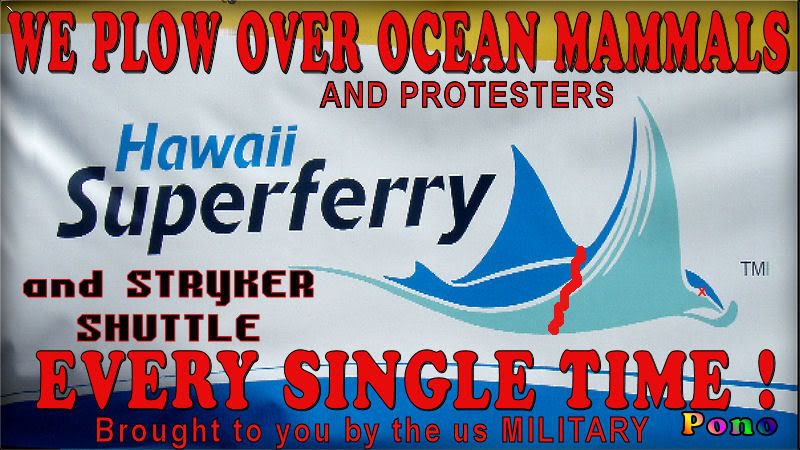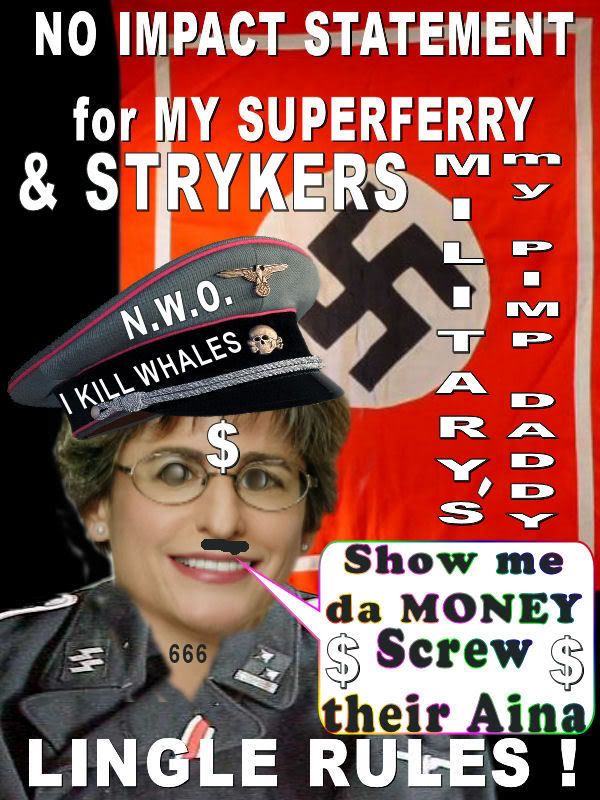


Superferry Lobbies For Military Upgrade
Company spends $210K on lobbyists to obtain funds for vehicle ramp
Hawaii Superferry has spent $210,000 since last summer to lobby for federal money to install features on its second high-speed catamaran to make it more attractive for military use.

Lobbyists hired by Superferry approached the U.S. Congress and the U.S. Department of Defense to help pay for a vehicle ramp and other improvements. The ramp would allow the new catamaran to load and unload vehicles at most large piers instead of relying on shore-based ramps and barges.
Superferry paid Blank Rome LLC, a prominent law and lobbying firm, to try to obtain federal money through the National Defense Features program to cover the cost of improvements to its second catamaran under construction at the Austal USA shipyard in Mobile, Ala. The defense program covers the installation of militarily useful features on commercial ships if the owners agree to make the ships available to the military during emergencies.
Superferry also may eventually retrofit the Alakai, which is now in commercial passenger and cargo service between O'ahu and Maui, with a vehicle ramp and other improvements. The improvements to the catamarans, if completed, would make the vessels self-sustaining and better suited for military assignments here and abroad. The second ferry is scheduled for delivery next February.
"Our customers have found that the current barge loading system is easy to use, fast and convenient, and works well for both cars and large trucks," Superferry said yesterday in response to questions from The Advertiser. "Adding a ramp to the vessel, in addition to our barges, would provide additional flexibility.
"We are looking at several options for improvements to be made under this program and ramps is one of them."
lobbying activities
The federal lobbying expenses, the most Superferry has spent with Blank Rome since it hired the firm in 2004, came during the time when Superferry was fighting for its survival in the Islands after court challenges and public protests. The state Supreme Court ruled in August that the state should not have exempted the project from environmental review. The state Legislature approved a bill, signed into law by Gov. Linda Lingle, that allowed the ferry to operate while an environmental impact statement is being prepared.
Superferry said yesterday that the lobbying activities at the federal level were unrelated to what was happening in the Islands and were about exploring available federal funding opportunities under the defense program.
Superferry's consideration of vehicle ramps on its catamarans validates the work of staff at the state Department of Transportation's harbors division. Staffers had argued in 2004 that Superferry should install a quarter stern ramp on the first catamaran because it would have saved the state on initial capital investments for shore-based ramps and barges, would have been less intrusive for other harbor users, and would have given the vessel more flexibility at Maui's congested Kahului Harbor.
Superferry countered that the ramp would add too much weight to the catamaran and hamper travel speed and load and unload time at harbors, which could reduce consumer convenience and the project's profitability.
The Department of Transportation's initial position was that the state would not pay for shore-based ramps and barges because other harbor users could request that the state buy or build their improvements. The state, however, ultimately agreed to $40 million in harbor improvements for the project that is supposed to be repaid by Superferry over time.
Harbors' staff made a pitch for Superferry to install a vehicle ramp in late 2004 but Superferry refused, according to documents released to The Advertiser under the state's open-records law. A Department of Transportation staffer, describing a meeting in the governor's offices with Bob Awana — then Lingle's chief of staff — and Superferry executives and department officials, wrote in an e-mail: "Decisions made: We need to pursue EXEMPTION; and HSF will not provide any ramps on vessel."
Mike Formby, the department's deputy director for harbors, said yesterday that there are pros and cons to adding vehicle ramps at this point. On-board ramps would give the catamarans more flexibility, but would likely not be as wide as the existing shore-based ramps that allow for easy loading and unloading. The ramp and barge configuration has caused problems at Kahului Harbor, where a tug has been necessary to keep the barge up against the pier during ocean swells, but has worked well at other harbors.
"While ramps will introduce flexibility into the system, they will also introduce some operational constraints," Formby said.
Dick Mayer, a retired economics professor who lives on Maui and has been active against the ferry, said the vehicle ramps and other improvements would make the catamarans more marketable elsewhere. "Those actions would place the investment made by the people and state of Hawai'i in jeopardy because the Superferry would be more easily able to leave," he said.
military component
Superferry executives had touted the military utility of the catamarans when they were initially describing the project to the state. A September 2004 document from Superferry, obtained by The Advertiser under the open-records law, discussed the growing training needs of the military in the Islands and said the catamarans would have strengthened vehicle decks to handle heavy military vehicles, helicopters, ammunition and other equipment.
John Lehman, a Superferry investor and former secretary of the Navy, and a Superferry executive told Pacific Business News in March 2005 of the ferry's potential to move the Army's Stryker brigade and other military equipment between O'ahu and the Big Island.
Sean Connaughton, administrator of the federal Maritime Administration, which provided federal loan guarantees for ferry construction, told a Maui court last year of the military utility of the ferry as part of the Voluntary Intermodal Sealift Agreement program. The program is a partnership between the military and the maritime industry to provide the military with sealift capacity during war or national emergency.
But Superferry executives have downplayed the military use of the catamarans since the court challenges and protests. Thomas Fargo, Superferry's president and chief executive officer and a retired Navy admiral, said when he took over the company in April that the success of the project would be built on commercial passenger and cargo business.
Several activists who oppose the project have been fixated on Superferry's military connections and have raised suspicions about whether it can be commercially profitable.
The Superferry catamarans are similar in design to Austal's WestPac Express, which has been contracted by the military as a support vessel in the Pacific.
Blank Rome's federal lobbying reports on Superferry for last year and the first quarter of this year have undergone substantial revision. The initial report for the last six months of last year, filed in February, showed less than $10,000 in lobbying income from Superferry. A second report in February raised the figure to $40,000. A third report, filed in May, put the figure at $120,000.
Blank Rome's lobbying report for the first quarter of 2008, filed in April, initially reported $30,000 in lobbying income from Superferry. An amended report, filed in May, raised the figure to $90,000.
The firm explained that the changes were made after the discovery of additional lobbying work on behalf of Superferry and because of the expenses from a subcontractor working with the firm on Superferry.
Reach Derrick DePledge at ddepledge@honoluluadvertiser.com.
• • •
 ponosize wrote:ms. DINGEL LINGEL da MILITAY'S SEWERFERRY HORE $$$$ YES I WAS ONE OF DA MANY , STADING OUR GROUND & PROTESTING THIS ~ HEWA~ TOO FRICKIN LATE FOR A TOLD U SO !THEIR GOES OUR AINA ! DA ILLEGAL PUPPET GOVERNMENT IN OUR ILLEGALLY OCCUPIED "SOVEREIGN NEUTRAL NATION" GETS ONE MORE NAIL IN OUR COFFIN !KU'E EA ! GO HOME USA & CLEAN UP NOT BUILD UP A HOLES !!hawaiiankingdom.org
ponosize wrote:ms. DINGEL LINGEL da MILITAY'S SEWERFERRY HORE $$$$ YES I WAS ONE OF DA MANY , STADING OUR GROUND & PROTESTING THIS ~ HEWA~ TOO FRICKIN LATE FOR A TOLD U SO !THEIR GOES OUR AINA ! DA ILLEGAL PUPPET GOVERNMENT IN OUR ILLEGALLY OCCUPIED "SOVEREIGN NEUTRAL NATION" GETS ONE MORE NAIL IN OUR COFFIN !KU'E EA ! GO HOME USA & CLEAN UP NOT BUILD UP A HOLES !!hawaiiankingdom.org

Comments
Letters to the Editor
Honolulu Advertiser/
Star-Bulletin
The Military Superferry Complex
So the use of the Superferry for military purposes is not
a myth afterall. What a pity this has been so downplayed.
The Superferry's use for military transport was intentional
from the start and must have been a major factor in its
creation. It would not be surprising if its "civilian"
use took a backdoor seat to future military planning
and objectives. Stay tuned.
Tony Castanha
Honolulu
ponosize wrote:
"educating Hawai'i's youth about wise stewardship of the islands and preserving our natural resources."
June 19, 2008
$500,000 released for Kauai Nature Center
HONOLULU – Gov. Linda Lingle has released a $500,000 capital improvement grant to the Hawai’i Nature Center to build an environmental and recreational center at the Wailua Reservoir on Kaua’i.
The planned 3,000 square-foot facility will provide Kaua‘i school children, residents and visitors with educational programs and outdoor nature experiences, and include an educational learning center with classrooms, a community meeting space and recreational area, according to a news release from the governor’s office.
Hawai’i Nature Center is a nonprofit organization dedicated to educating Hawai’i’s youth about wise stewardship of the islands and preserving our natural resources. This includes school programs for students in grades K-6 with lessons focused on science-based principles.
The Kaua’i facility is estimated to cost $4.5 million. To cover remaining costs, the organization will be launching a capital campaign and applying for additional federal and foundation funding.
Design of the facility is to begin in July 2008 and be completed a year later. Construction is scheduled to commence in September 2009 and be completed in December 2011